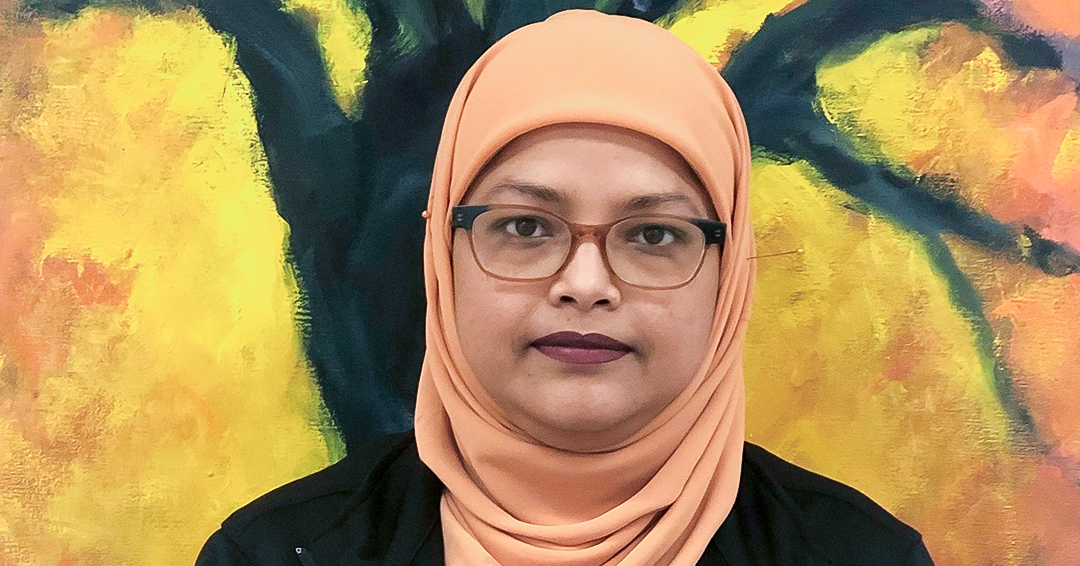
International medical grad shares her journey from family doctor in Bangladesh to pathology resident at McGill
A career in medicine can seem like a long and winding road, littered with obstacles. Each journey is unique, but occasionally one stands out as particularly unusual and inspiring. Such is the case of Tahmina Sultana, M.D., who studied medicine in her native Bangladesh and was a family physician for several years before immigrating to Canada. “I knew that I wanted to practise medicine in my new home,” Dr. Sultana explains. “But foreign trained doctors must first take qualifying exams and complete residencies in order to gain a medical licence.” In addition, those arriving in Quebec must also learn French.
It’s an arduous, yet necessary, process that ensures that all physicians follow the same practices and work to the same standards. It may have seemed daunting, but a journey of a thousand miles begins with a single step, and for Dr. Sultana the logical place to start was the language. “I spent my first year in Quebec becoming fluent in French,” she recalls. “It wasn’t easy, but I started to enjoy it and learned quickly, according to my teacher.”
Dr. Sultana then applied for hospital work that didn’t require a medical license. “I wanted to get back into health care and learn how the Canadian system worked,” she says. “I was ready to do anything, so I applied for volunteer positions as a patient attendant.” Despite her eye-popping resume, she received no response. It was during a visit to St. Mary’s Hospital, to apply for a similar position, that Dr. Sultana had a chance encounter with pathologist Indrojit Roy, M.D., who took her under his wing and helped arrange an interview as a pathology assistant.
“I was so happy,” recalls Dr. Sultana. “Pathology is a speciality that I’ve always been interested in, and Dr. Roy inspired me to follow that path.” According to Dr. Sultana, the pathology assistant is the beating heart of pathology. Their specimen grossing work, which involves receiving, evaluating, and sectioning biopsy specimens, is almost an art-form and vital to ensuring patients receive accurate diagnoses and suitable treatments.
This position reinforced Dr. Sultana’s desire to return to medicine and, more specifically, to apply to the McGill Pathology residency program. What followed was four years balancing a 9-to-5 job with long evenings of study. “I would return home from work to enjoy some family time, and then once my son went to bed I would open my books and study for six hours each night for my medical qualifying exams,” she says. “It was a difficult time, but I had the support of my family and colleagues at St. Mary’s behind me.”
Dr. Sultana passed her exams and became eligible for the Canadian Resident Matching Service (CaRMS). Within CaRMS, medical graduates list their preferred programs and programs list their preferred applicants; the CaRMS computer algorithms then go to work connecting the two in the fairest way possible. The results are published across Canada at the same time (12pm EST) on what has become known as “match day.”
Most applicants spend the morning chewing their fingernails, trying not to focus on the fact that their medical career path will be revealed in just a few hours. Dr. Sultana went to work. “I couldn’t just sit and wait for the result,” she says. “I love my work and it was the best way to take my mind off it.” As noon approached, Dr. Sultana’s colleagues gathered around her. “My heart was racing as I logged in to check the match results,” she recalls. “I was very anxious, but I got the match I wanted, and we all celebrated. The door was finally open for me to get my licence back and practise medicine in my new home.”
The one downside of Dr. Sultana’s success was that she would be leaving her position as a pathology assistant. After four years, she had acquired essential skills that were supporting patient care across the hospital. “My former academic director, Zu-hua Gao, M.D., and one of my colleagues, Ayesha Baig, had the idea of using educational videos to pass on my knowledge of grossing,” Dr. Sultana says. Research suggests that videos can convey knowledge better than printed materials, because they provide an immersive experience where techniques can be demonstrated. “I was thrilled to help develop a teaching aid that could be useful for years to come,” she says.
Dr. Sultana spent hours combing through specimens to find examples that best illustrated the specific educational goals. “We then had to write a script, which was reviewed and edited by my colleagues, and film the work, which required professional staging, lighting, voice-over and editing.” Initially a professional editor was used, but the process of reviewing and editing the content was so time-consuming that Dr. Sultana decided to simply learn the editing software herself, which cut production time to just 10 days from one month. Dr. Sultana also included innovative quiz sections in the videos, to help reinforce the knowledge covered.
These videos will be available to the medical community later this year through Pathology Review and Practice Guide (third edition) by Dr. Gao. Dr. Sultana, who is now in the third year of her pathology residency, has completed 10 videos so far and has plans to create many more.
Dr. Sultana would additionally like to thank = Khldoun Bakdounes, M.D., Jason Karamchandani, M.D., Pierre Olivier Fiset, M.D., Chelsea Maedler-Kron, M.D. and Mr. Jonathan Lai, M.D., MSc, for all their support.
